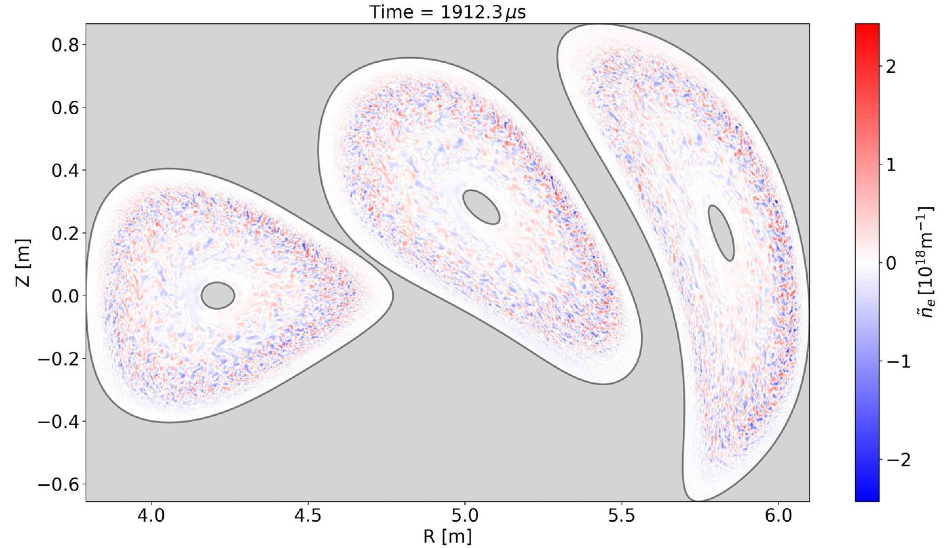Created at Max Planck Institute for Plasma Physics at Garching, Germany, the turbulence code GENE—which stands for Gyrokinetic Electromagnetic Numerical Experiment—has demonstrated to be extremely handy for the theoretical description of turbulence in the plasma of tokamak-type fusion devices.
 Turbulence calculation with the GENE-3D code for Wendelstein 7-X: The snapshot shows the turbulent variation of the plasma density over different cross-sections of the plasma ring. In contrast to tokamaks, whose ring-shaped plasma has the same cross-section everywhere, the cross-section changes its shape in stellarators. Image Credit: Illustration: IPP, A. Bañón Navarro.
Turbulence calculation with the GENE-3D code for Wendelstein 7-X: The snapshot shows the turbulent variation of the plasma density over different cross-sections of the plasma ring. In contrast to tokamaks, whose ring-shaped plasma has the same cross-section everywhere, the cross-section changes its shape in stellarators. Image Credit: Illustration: IPP, A. Bañón Navarro.
Also used for the more complex geometry of stellarator-type devices, computer simulations with GENE currently indicate a novel technique to decrease plasma turbulence in stellarator plasmas. This may considerably boost the efficiency of an upcoming fusion power plant.
The turbulence formation in its fuel—that is, a hydrogen plasma—is a fundamental research topic for fusion scientists at Max Planck Institute for Plasma Physics, who want to create a power plant based on the Sun model. The small eddies carry particles and heat from the hot plasma center, thus reducing the thermal insulation of the magnetically confined plasma.
Since the size and therefore the cost of electricity of an upcoming fusion power plant are dependent on it, one of the most significant goals is to interpret, estimate, and govern this “turbulent transport.”
Plasma Turbulence
For accurate computational description of plasma turbulence, highly complex systems of equations would be required and this would also involve an unlimited number of computational steps; therefore, the code development process is targeted at realizing practical simplifications.
Developed at Max Planck Institute for Plasma Physics, the GENE code is based on a group of streamlined, so-called gyrokinetic equations. It ignores all phenomena in the plasma which do not have a crucial role to play in the turbulent transport.
While the computational effort can be decreased by many orders of magnitude in this manner, the fastest and most powerful supercomputers in the world were invariably required to additionally develop the code.
Meanwhile, GENE is capable of explaining the formation and propagation of small low-frequency plasma eddies in the plasma interior well, and is also capable of reproducing and describing the experimental outcomes—but originally only for the easily built axisymmetric fusion devices of the tokamak type.
For instance, calculations made using the GENE code demonstrated that fast ions can considerably decrease the turbulent transport in tokamak plasmas. This result was confirmed by experiments performed at the ASDEX Upgrade tokamak at Garching. Plasma heating using radio waves of the ion cyclotron frequency provided the required fast ions.
A Tokamak Code for Stellarators
In the case of stellarators, scientists have not observed this turbulence suppression by fast ions at the experimental level to date. However, the new calculations made with the GENE currently indicate that such an effect should also be present in stellarator plasmas. In the Wendelstein 7-X stellarator at Max Planck Institute for Plasma Physics at Greifswald, this effect could theoretically decrease turbulence by over 50%.
As described by Alessandro Di Siena, Alejandro Bañón Navarro, and Frank Jenko—all scientists at Max Planck Institute for Plasma Physics—in the Physical Review Letters journal, the optimal ion temperature strongly relies on the shape of the magnetic field.
If this calculated result is confirmed in future experiments with Wendelstein 7-X in Greifswald, this could open up a path to interesting high-performance plasmas.
Frank Jenko, Professor and Head of the Tokamak Theory Department, Max Planck Institute for Plasma Physics
To use the GENE code for turbulence calculation in the more intricately shaped plasmas of stellarators, the code had to be considerably adjusted. In the absence of the axial symmetry of the tokamaks, one needs to manage with a relatively more complex geometry for stellarators.
For Professor Per Helander, head of the Stellarator Theory department at Max Planck Institute for Plasma Physics in Greifswald, the stellarator simulations conducted with GENE are “very exciting physics.”
Professor Per Helander hopes that the outcomes can be validated in the Wendelstein 7-X stellarator at Greifswald.
Whether the plasma values in Wendelstein 7-X are suitable for such experiments can be investigated when, in the coming experimental period, the radio wave heating system will be put into operation in addition to the current microwave and particle heating.
Robert Wolf, Professor, Max Planck Institute for Plasma Physics
Professor Wolf’s department is responsible for plasma heating.
GENE Becomes GENE-3D
For Frank Jenko, it was another “enormous step” to make GENE approximately and also fully fit for the complex, 3D shape of stellarators.
After nearly five years of development work, the GENE-3D code, currently described in the Journal of Computational Physics by Maurice Maurer and co-authors, offers a “fast and yet realistic turbulence calculation also for stellarators,”added Frank Jenko.
The GENE-3D code, unlike other stellarator turbulence codes, explains the full dynamics of the system, that is, the turbulent movement of the ions as well as the electrons across the whole inner volume of the plasma, such as the resulting variations of the magnetic field.
Turbulenzrechnung mit dem Code GENE-3D für Wendelstein 7-X
The video shows the turbulent variation of plasma density over the cross-section of the plasma ring of the Wendelstein 7-X stellarator. Video Credit: IPP, A. Bañón Navarro.
Journal Reference:
Di Siena, A., et al. (2020) Turbulence Suppression by Energetic Particle Effects in Modern Optimized Stellarators. Physical Review Letters. doi.org/10.1103/PhysRevLett.125.105002.